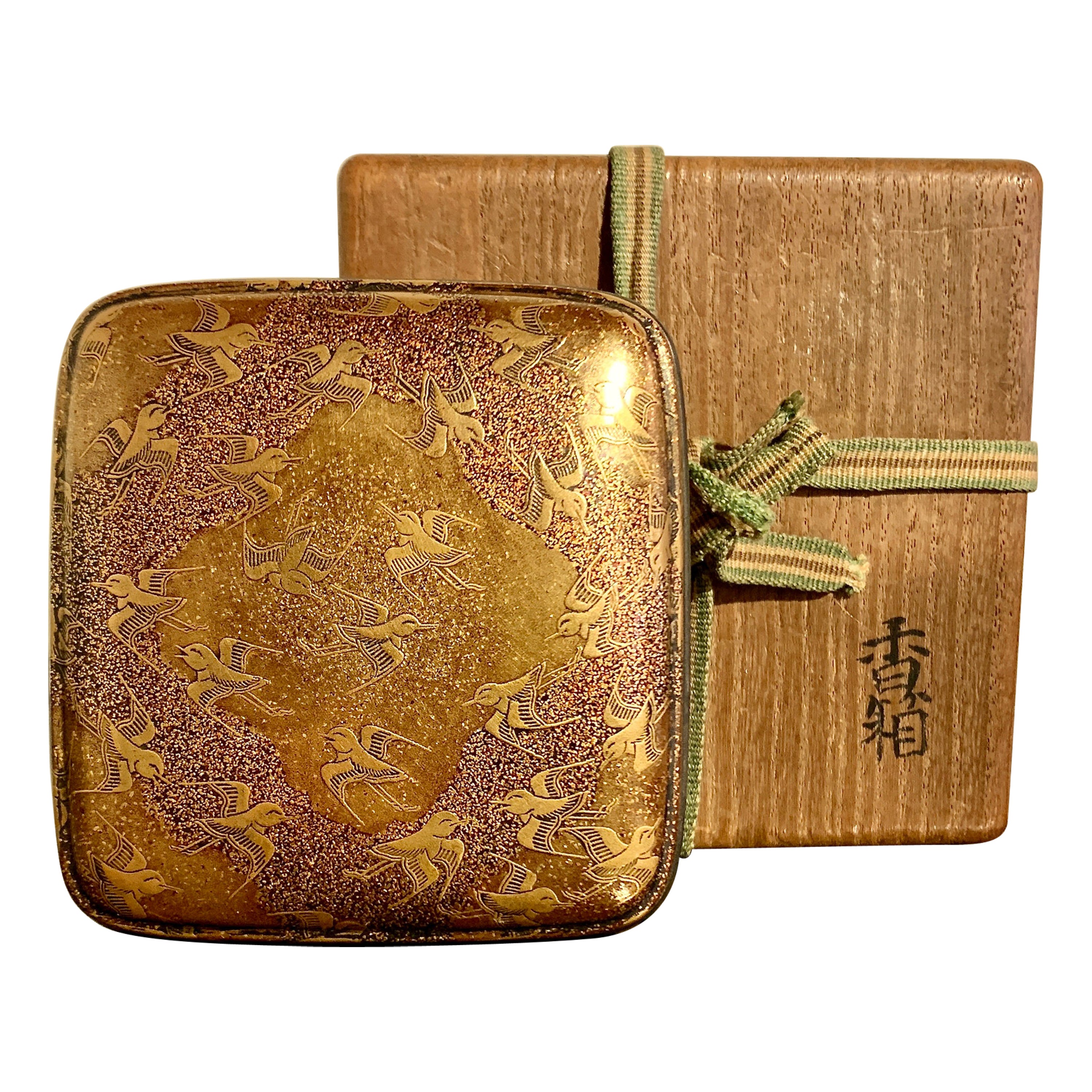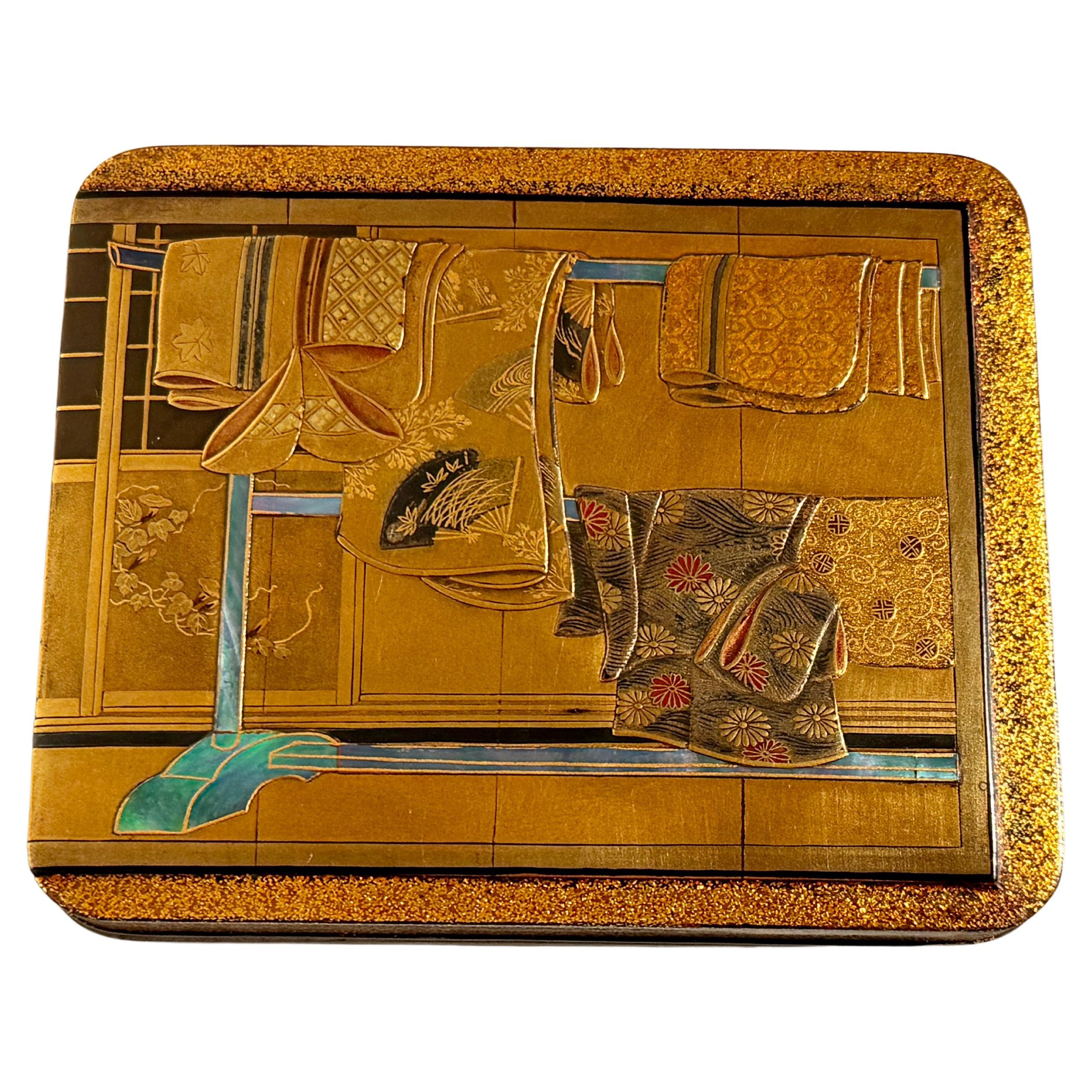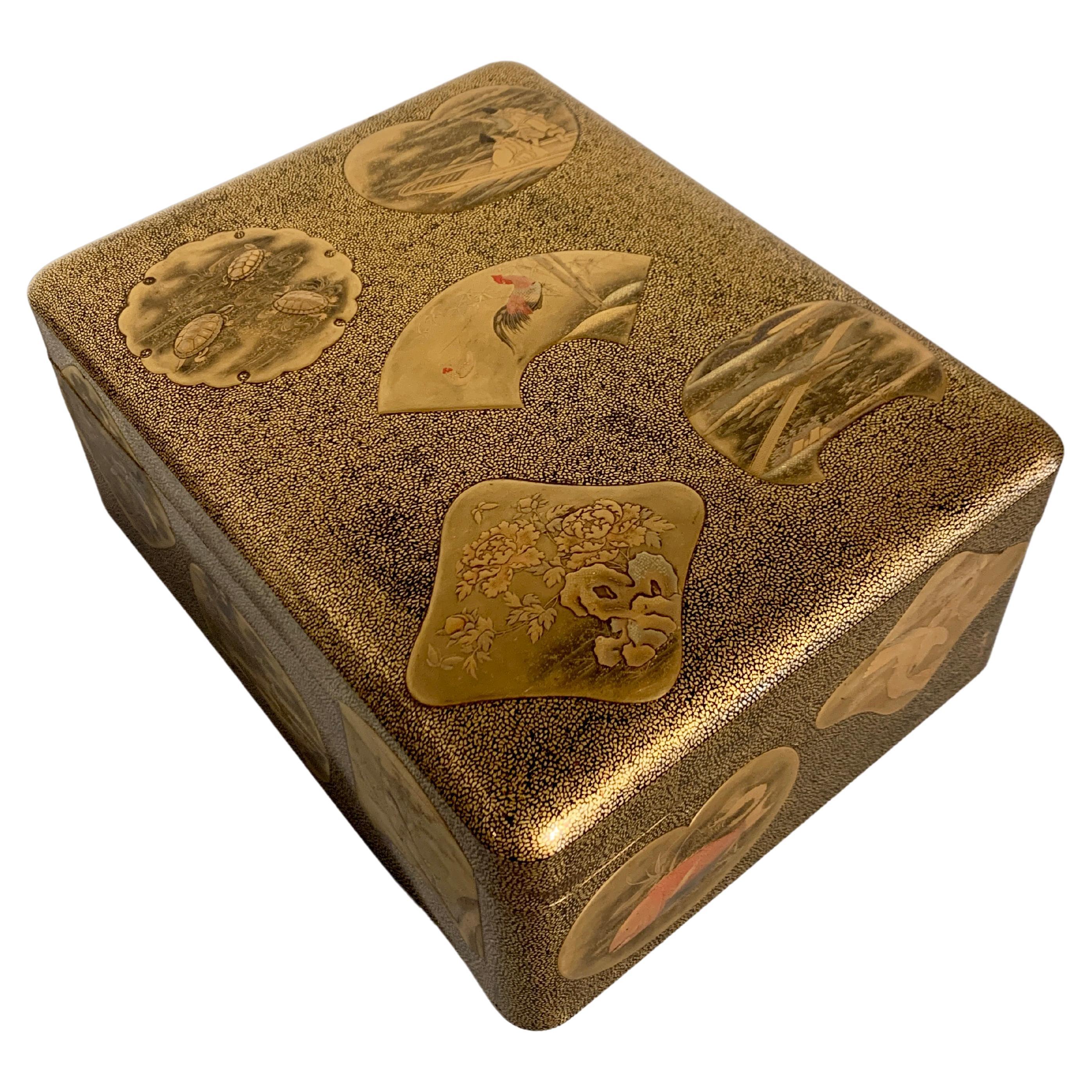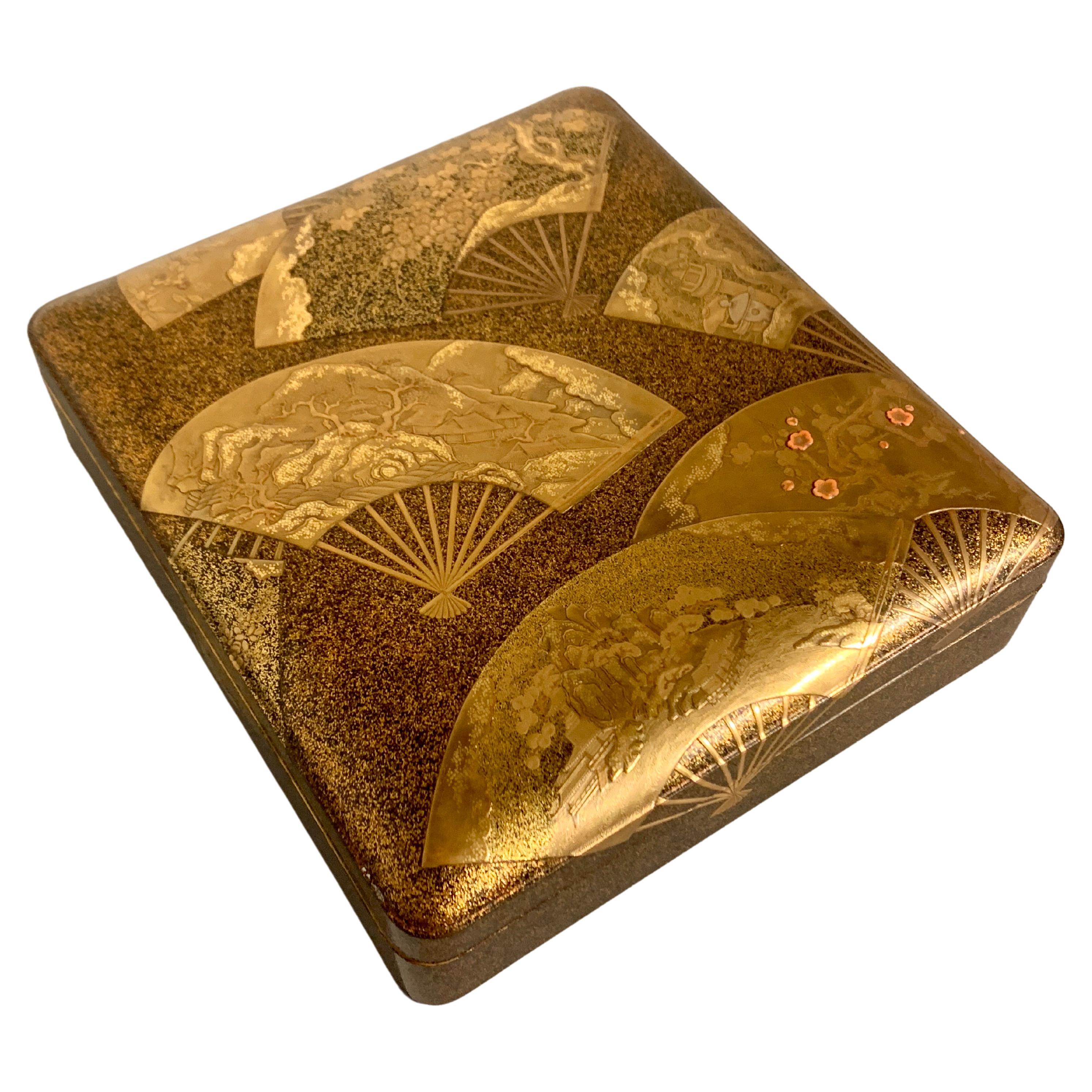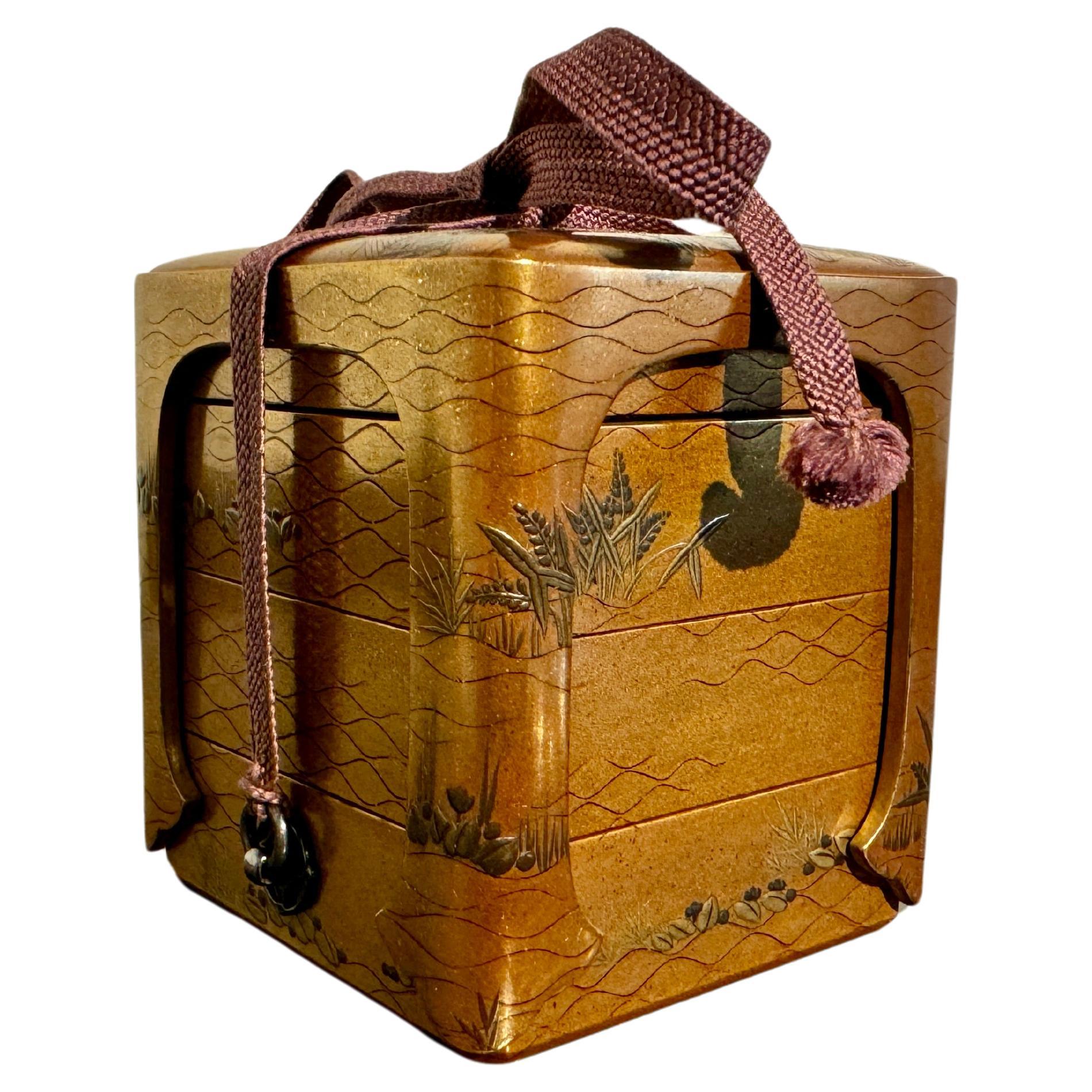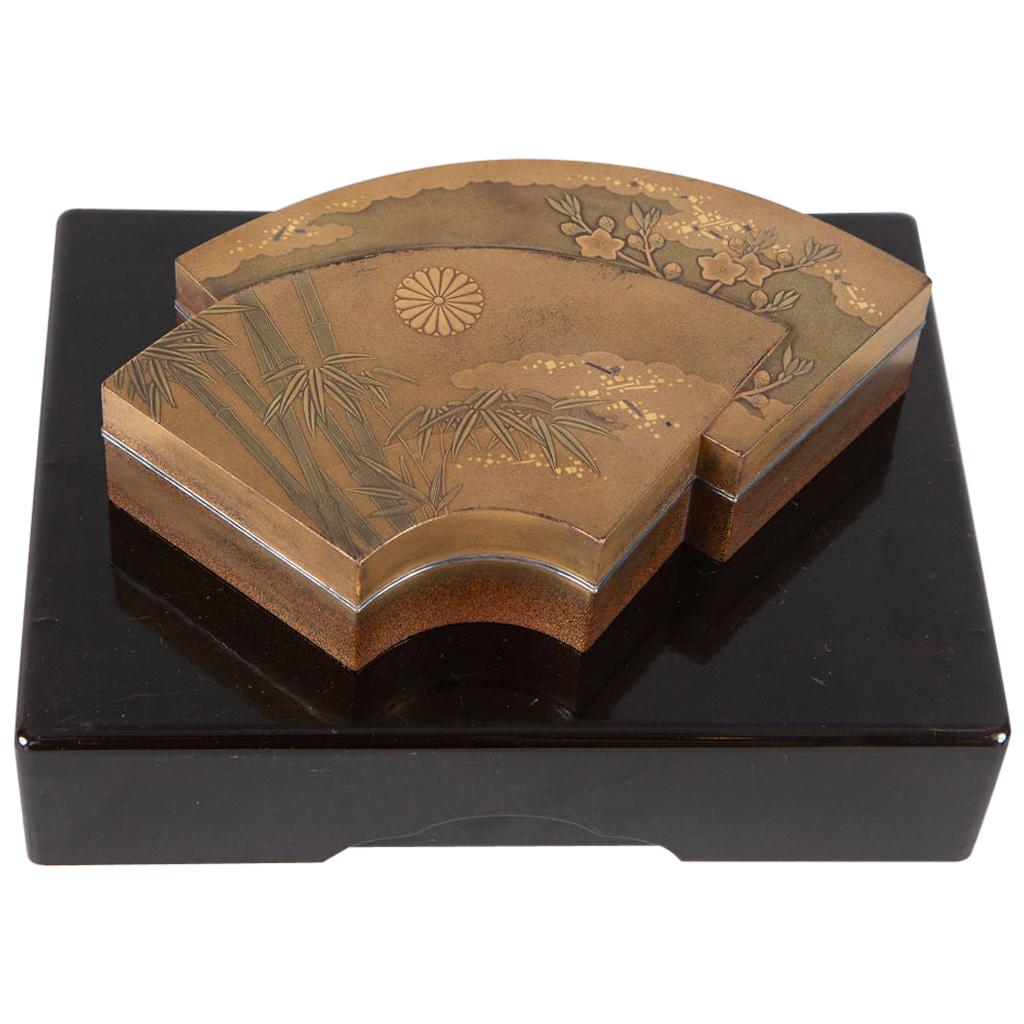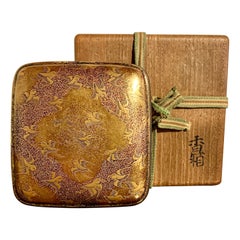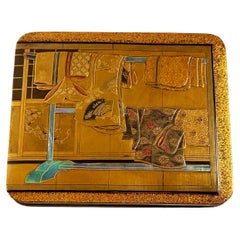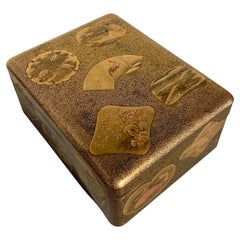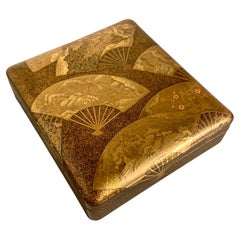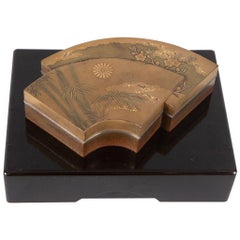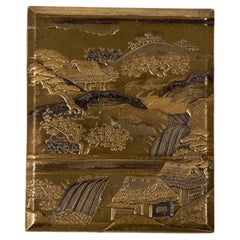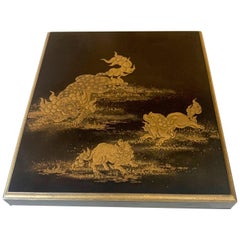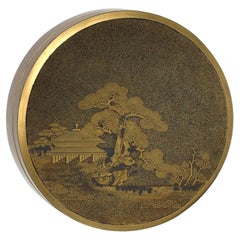Items Similar to Japanese Lacquer Incense Accessories Box, Kobako, Edo Period, mid 19th c, Japan
Want more images or videos?
Request additional images or videos from the seller
1 of 19
Japanese Lacquer Incense Accessories Box, Kobako, Edo Period, mid 19th c, Japan
$8,500
£6,530.24
€7,503.17
CA$11,956.30
A$13,432.37
CHF 7,018.43
MX$163,948.36
NOK 89,113.62
SEK 83,881.70
DKK 55,991.41
About the Item
A remarkable Japanese maki-e lacquer box for incense accessories, kobako, with interior fitted tray, kakego, designed with a temple complex scene, late Edo Period, mid 19th century, Japan.
The exquisite box features an all over design of a sprawling lakeside temple complex nestled amongst hills. Tall pines soar overhead while a rushing stream flows over waterfalls to feed the lake. Gold dusted clouds and a dreamy gold sprinkled night sky serve as the background.
The main hall of the temple looks out over the lake and is surrounded by lush foliage. A three tiered pagoda peeks out in the background. The sides of the box seem to offer more views of the temple complex and various buildings from a different angle. The interior tray, kakego, with another view of the temple complex.
The flush fitting lid, inrobuta, of slightly domed form. As with the best Japanese lacquer boxes, the design transitions seamlessly from the cover down to the body of the box.
The lacquer worked in fine silver and gold maki-e, using various techniques, including takamaki-e, hiramaki-e, hirameiji, okibirame, and nashiji. The interior and underside of the box and tray of fine nashiji.
With an inscribed storage box, tomobako.
Kobako are instrumental parts of kodo, incense ceremonies. They are used to hold accessories necessary for the ceremony.
Provenance:
Bonhams, NY
Alan and Simone Hart Collection
Measurements of the box only:
W: 5.75"
H: 2.25"
D: 4.5"
- Dimensions:Height: 3.75 in (9.53 cm)Width: 7.25 in (18.42 cm)Depth: 5.5 in (13.97 cm)
- Style:Edo (Of the Period)
- Materials and Techniques:
- Place of Origin:
- Period:
- Date of Manufacture:circa 1850
- Condition:Repaired: One small repair to the upper left corner of the interior tray. Wear consistent with age and use. Minor losses. Minor structural damages. In overall very good condition with minimal wear. The inner tray with one minor repair with associated loss to the top left corner, as seen in photos.
- Seller Location:Austin, TX
- Reference Number:1stDibs: LU894741196612
About the Seller
5.0
Gold Seller
Premium sellers maintaining a 4.3+ rating and 24-hour response times
Established in 2001
1stDibs seller since 2010
346 sales on 1stDibs
Typical response time: 1 hour
- ShippingRetrieving quote...Shipping from: Austin, TX
- Return Policy
Authenticity Guarantee
In the unlikely event there’s an issue with an item’s authenticity, contact us within 1 year for a full refund. DetailsMoney-Back Guarantee
If your item is not as described, is damaged in transit, or does not arrive, contact us within 7 days for a full refund. Details24-Hour Cancellation
You have a 24-hour grace period in which to reconsider your purchase, with no questions asked.Vetted Professional Sellers
Our world-class sellers must adhere to strict standards for service and quality, maintaining the integrity of our listings.Price-Match Guarantee
If you find that a seller listed the same item for a lower price elsewhere, we’ll match it.Trusted Global Delivery
Our best-in-class carrier network provides specialized shipping options worldwide, including custom delivery.More From This Seller
View AllJapanese Lacquer Incense Box, Kogo, Momoyama or Edo Period, 16th/17th Century
Located in Austin, TX
A wonderful Japanese lacquer incense box, kogo, with a design of plovers in flight, late Momoyama or early Edo Period, circa 1600, Japan.
The small box, called a kogo, was used to s...
Category
Antique Early 17th Century Japanese Edo Lacquer
Materials
Gold, Pewter
Japanese Tagasode (Whose Sleeves?) Lacquer Incense Box, Kobako, Meiji Period
Located in Austin, TX
A fine and unusual Japanese lacquer box for incense accessories, kobako, featuring a tagasode (whose sleeves?) design, Meiji Period, circa 1900, Japan.
The exquisite box of simple rectangular shape worked in maki-e lacquer, taka-maki-e, and raden, all against a lush ground of gold nashiji. Fitted with silver rims.
The main decorative element of the box depicts a six panel folding screen, byobu, showing an interior scene with kimono strewn over a rack, a motif known as tagasode (whose sleeves), all in raised taka-maki-e lacquer and inlaid raden.
The screen depicts an intimate room with tatami mats on the floor and sliding shoji doors in the background. The foreground depicts a large clothing...
Category
Antique Early 1900s Japanese Meiji Lacquer
Materials
Silver
Large Japanese Lacquer Document Box, Ryoshibako, Edo/Meiji period, Japan
Located in Austin, TX
A large and magnificently decorated Japanese lacquer document box, ryoshibako, signed Umeboshi/Baikyo, late Edo or early Meiji Period, mid 19th century, Japan.
The large document box, ryoshibako, of tall, rectangular shape with rounded corners, and fitted with an inrobuta (flush-fitting) cover with beveled edges. The exterior of this exquisite box is decorated all over with fifteen different raised reserves shaped as uchiwa (paddle) fans against a lush and intricate krikane ground imitating shagreen.
The uchiwa shaped reserves all of takamaki-e, and exquisitely painted with designs of animals, flowers, and landscapes in silver, gold, maki-e, hiramaki-e, and takamaki-e, with kirikane, nashiji, and polychrome embellishments, upon gold lacquer fudame grounds.
The interior of the lid is nothing short of spectacular, featuring a large design of a magnificent and beautifully detailed rooster and hen with chicks gathered around a lazy stream. Large stalks of chrysanthemum bloom behind them. All against an ethereal nashiji ground.
The cover of the box features five reserves:
1. Three minogame (turtles with long tails), symbolizing longevity
2. "Narihira Crossing the Sumida" from The Tales of Ise...
Category
Antique 1860s Japanese Meiji Lacquer
Materials
Softwood, Lacquer
Japanese Maki-e Lacquer Document Box, Edo Period, early 19th Century, Japan
Located in Austin, TX
A spectacular Japanese maki-e lacquer lidded box, possibly a writing box, suzuribako, decorated with images of folding fans, ogi, Edo Period, earl...
Category
Antique Early 19th Century Japanese Edo Lacquer
Materials
Coral
Japanese Stacking Incense Box, Ju-Kobako, Meiji Period, Mid 19th century, Japan
Located in Austin, TX
An exquisite small Japanese maki-e lacquer stacking box for incense and accessories, ju-kobako, late Edo or early Meiji Period, mid 19th century, Japan.
Crafted in maki-e lacquer an...
Category
Antique Mid-19th Century Japanese Meiji Lacquer
Materials
Silver
Japanese Lacquer Writing Box, Suzuribako, Edo Period, 18th Century, Japan
Located in Austin, TX
An exceptionally fine and unusual Japanese lacquer writing implements box, suzuribako, in the form of a zither, koto, Edo Period, 18th century, Japan. With a modern wood storage box,...
Category
Antique 18th Century Japanese Edo Lacquer
Materials
Gold, Silver, Copper
You May Also Like
Japanese Lacquer Kogo 'Incense Box'
Located in Hudson, NY
Late Edo (1614 - 1868) period incense storage box in stacked, double fan design. Fans have bamboo and plum design with a chrysanthemum crest. Silve...
Category
Antique Mid-19th Century Japanese Edo Lacquer
Materials
Gold
Japan lake landscape kobako box lacquer - Edo
Located in PARIS, FR
Rectangular kobako box in takamaki-e and kirigane gold lacquer circled with pewter depicting a lake landscape. Inside and back of the box in nashi-ji lacquer.
Japan – Edo period (16...
Category
Antique 18th Century Japanese Lacquer
Materials
Gold
Japanese Lacquer Box with Fine Maki-e Decoration Meiji Period
Located in Atlanta, GA
A lacquered wood box with lid from Japan circa 19th century Meiji Period. The finely decorated box was used to store paper slips and small documents on the desk. It is overall finished with black lacquer (kuro) with sparse Mura-Nashiji effect outside and on the top surface of the lid, there are three Komainu, (sometimes known as Shishi or Japanese lions) frolicking and forming a circle in lively motion. Komainu are auspicious animals in Japanese cultures in both Shinto and Buddhism tradition. Originally from China, these animals symbolizes guardians to ward off evil spirits. Hiramaki-e was used in combination with carving and combing to render the lions with various surface textures. A gilt border with an slight angle was given to the lid and even the thin band is decorated with miniature floral scrolls. The interior of the box was finished in a dense nashiji. Underneath the lid, a cluster of peonies open lavishly by two gentle mounts. Takamaki-e (high relief) in both gold and silver were...
Category
Antique Late 19th Century Japanese Japonisme Lacquer
Materials
Wood, Lacquer
Japanese Gilt Lacquer Covered Sweet Meat Box
Located in West Palm Beach, FL
Japanese Gilt Lacquer Covered Sweet Meat Box
Meiji Period. The circular box decorated with a raised evergreen tree before a pavilion, opening to multip...
Category
20th Century Antiquities
Materials
Giltwood
Japanese Rinpa Style Lacquer Ink Stone Box Suzuribako
Located in Atlanta, GA
A Japanese writing box with ink stone (known as Suzuribako) with exquisite maki-e decoration circa late Meiji to early Taisho period (1890s-1930s)...
Category
Early 20th Century Japanese Japonisme Lacquer
Materials
Wood, Lacquer
Japanese Meiji Period Antique Lacquer Box with Gold Maki-e Decoration
Located in New York, NY
A fine antique Japanese Meji Period lacquer box decorated with a fan and a stylized star shaped window in the maki-e technique. The fan at the top right corner, fully opened depictin...
Category
Antique 19th Century Japanese Meiji Lacquer
Materials
Lacquer
More Ways To Browse
Japanese Mid Century Design
Edo Period Japanese Art
Antique Lacquer Box
Antique Lacquer Boxes
Japanese Painted Silk
Japanese Lacquer Boxes
Edo Period Gold
Asian Storage Box
Antique Cypress
Antique Cypress Furniture
Japanese Pagoda
Temple Lacquer
Japanese Incense
Gold Lacquer Tray
Antique Japanese Silver Box
Silver Antique Japanese Boxes Silver Boxes
Japanese Silver Tray
Pagoda Box
